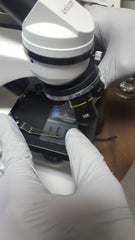A few things I wish I'd known as a young brewer
- What the heck is Irish Moss? This kettle fining additive may appear in recipes from time to time and you'll see it listed as being added during the last 15 minutes of the boil. Irish Moss is actually an edible red sea weed, so if you take a whiff you may find it reminiscent of a marina/fish market. The active compound that we brewers are interested in is called carageenan. This is the same compound used in Whirlfloc tablets.
Carageenan carries a negative charge and the proteins in our wort carry a positive charge. When we add the fining agent to the boil, it roils around attracting proteins to itself; this effectively creates larger particles. When we chill the wort, it is easier for these larger particles to drop out and settle to the bottom, leaving a clearer, less protein-laden beer wort. What does this mean? It means we don't end up with these proteins or carageenan in the final beer.
If you want great clarity and also want to significantly reduce the gluten content and you are adverse to using carageenan, try Clarity Ferm. This enzyme, developed by White Labs, is added to the fermenter when you pitch the yeast. After fementation is complete, everything settles out and you're left with brilliant gluten-reduced beer.
- Cleaning and Sanitizing- These are different processes. The first is the process of removing physical particulates, such as yeast scum build-up on the walls of the fermenter. Sanitizing follows cleaning and is defined as removing 99.999% of microorganisms. If something is not clean, it cannot be sanitized. Remember, you can't sanitize dirt. Cleaners will be labelled as cleaners, and approved sanitizers will say sanitizer. Note: winemakers often use metabisulphite solutions as sanitizers; this is not recommended for beer brewers.
For cleaners, we offer Oxygen Brewery Wash (OBW) and Powdered Brewery Wash (PBW). Both are very effective and should be rinsed with hot water after use.
We carry two quality sanitizers. Io-Star is a non-foaming iodine-based sanitizer that requires one minute of contact time to be effective. It will stain plastic if allowed prolonged exposure, but this is just aesthetic. Star San is a phosphoric acid-based sani that requires five minutes of contact time and foams. Sanitizers should not be rinsed.
- Fermentation Temperature- This can be the difference between good beer and great beer. Yeast will perform differently and create different compounds when subjected to varying temperatures. Always make sure that you ferment in a relatively temperature-stable environment and try to stay within a yeast's ideal range. Every yeast is different, so a comprehensive explanation of differences is impractical here, but we are always willing to offer advise as to the best yeast for your temperatures.
Playing with fermentation temperature is one more way that we can manipulate the final profile of a beer or wine. For example, California Ale or champagne yeast will be cleaner and more neutral when fermented at the low end of their range, and they'll be more estery (esters are aromatic compounds produced by yeast) and less neutral if fermented hotter. Saison yeasts and other Belgian yeasts may be too bubblegummy or underattenuate (not ferment completely) if they aren't fermented hot enough. Hefeweizen yeasts will give you more of the banana and fruit esters when fermented hot and more of the clove-like phenolics when fermented cooler.
- Pitch rates- Start looking into yeast starters. Pitching the appropriate amount of yeast can also mean the difference between good beer and great beer. A single vial of yeast when fresh contains approximately 100 billion cells. It's not that a vial won't ferment out a wort, but it may underattenuate and/or can produce some off-flavors or aromas because it's too stressed out. It's also quite possible that the beer won't taste or smell bad at all, but it won't be quite as crisp or "right" as it could otherwise be with a higher pitch rate. It is also worth noting that nearly all dry yeasts (11gram packs) contain about 200 billion cells, a more adequate number for most ferments. Some good resources are Mr. Malty and Brewers Friend.
- Theodore Clevenger


Comments 0